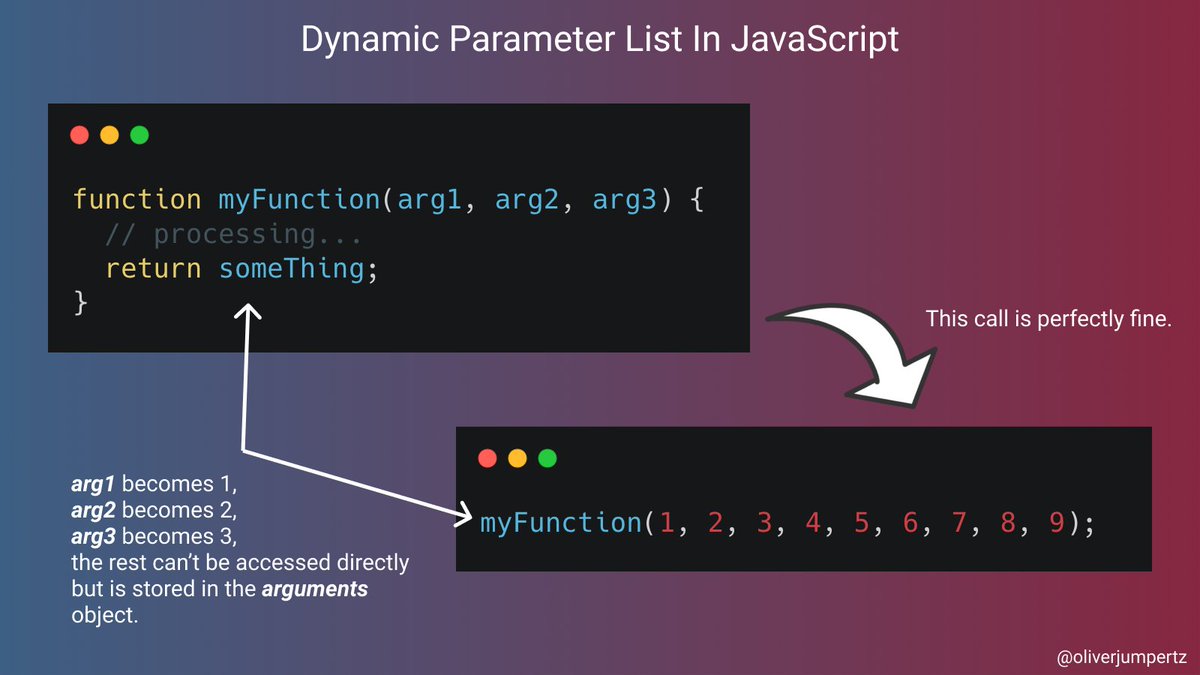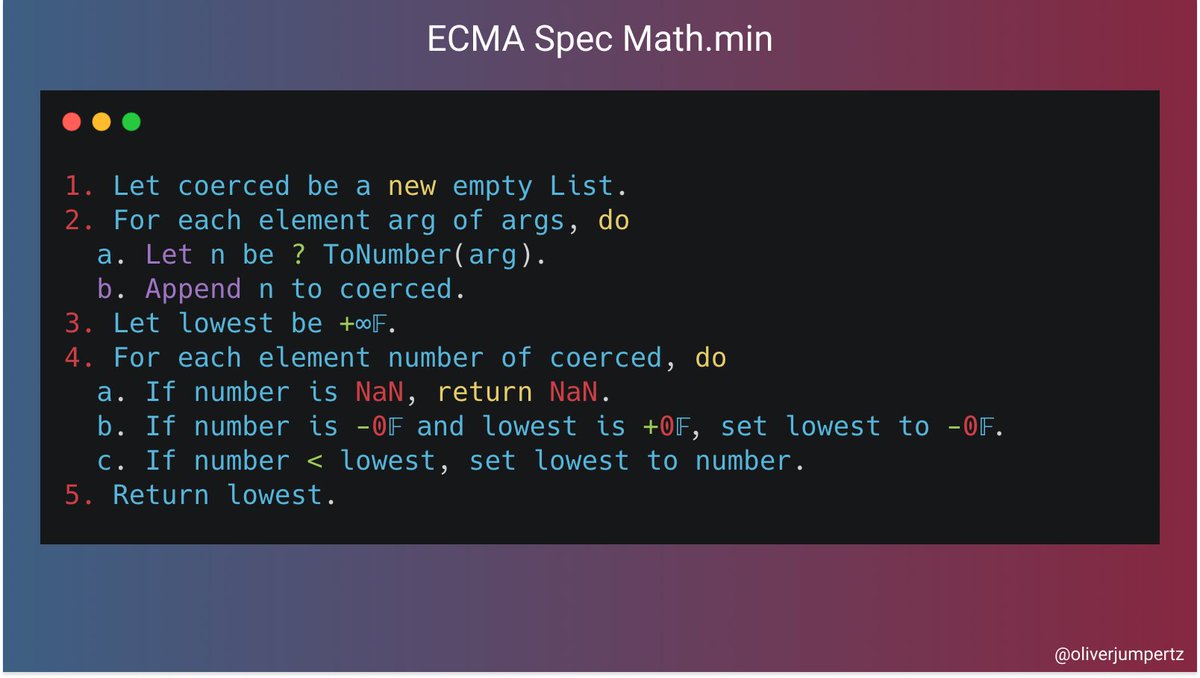
Did you know that Math.max() < Math.min() in JavaScript?
It's a fun fact about the language that is periodically brought up, but do you know why this actually happens?
Let's take a quick look at Math.max and Math.min to understand the issue.
A thread.
It's a fun fact about the language that is periodically brought up, but do you know why this actually happens?
Let's take a quick look at Math.max and Math.min to understand the issue.
A thread.
1. Is this a quirk or a bug?
No, it is neither a quirk nor a bug.
There are two things you need to realize first:
1. Math.max and Math.min are functions
2. JavaScript is dynamic
1/21
No, it is neither a quirk nor a bug.
There are two things you need to realize first:
1. Math.max and Math.min are functions
2. JavaScript is dynamic
1/21
-> Math.max() and .min() are functions
Both functions are actually not meant to return any maximum or minimum displayable value for numbers.
Both are meant to find the max or min value from:
1. Two arguments
2. An array of values
2/21
Both functions are actually not meant to return any maximum or minimum displayable value for numbers.
Both are meant to find the max or min value from:
1. Two arguments
2. An array of values
2/21
-> JavaScript is dynamic
Any function can take an arbitrary amount of parameters, although only a few might actually be named in a function's signature.
Those parameters are always type-less because JavaScript is a dynamically typed language.
3/21
Any function can take an arbitrary amount of parameters, although only a few might actually be named in a function's signature.
Those parameters are always type-less because JavaScript is a dynamically typed language.
3/21

This leads to that you can't have multiple versions of a function with different parameter lengths or parameter types.
There is always only one version of a function.
If you want to support something like this, you need to implement it manually.
4/21
There is always only one version of a function.
If you want to support something like this, you need to implement it manually.
4/21
Thus, the implementation needs to support:
1. 0 arguments passed
2. one argument passed
3. two arguments passed
4. more than two arguments passed
And all this within one function implementation.
5/21
1. 0 arguments passed
2. one argument passed
3. two arguments passed
4. more than two arguments passed
And all this within one function implementation.
5/21
2. Understanding the behavior
Let's imagine you want to implement Math.max as an example.
What would you need to do to find the maximum of an arbitrary amount of values?
You need a value to compare against.
6/21
Let's imagine you want to implement Math.max as an example.
What would you need to do to find the maximum of an arbitrary amount of values?
You need a value to compare against.
6/21
If you get two values, you would be fine to compare the two values and return the greater one.
This covers one case.
7/21
This covers one case.
7/21

But what if you only get one value?
The max value of one argument provided must be the value itself.
8/21
The max value of one argument provided must be the value itself.
8/21

Okay, but what now? You still need to cover the case that an arbitrary amount of values is provided.
As you learned previously, 'arguments' is a special variable in a function that contains all arguments that were passed to a function.
You can loop over these.
9/21
As you learned previously, 'arguments' is a special variable in a function that contains all arguments that were passed to a function.
You can loop over these.
9/21
But you still need a value to compare against.
The first iteration needs to check whether the first argument is greater than something.
But what is this something?
Is it 0? No, because what about -1, then? -1 could still be greater than -2 and -3...
10/21
The first iteration needs to check whether the first argument is greater than something.
But what is this something?
Is it 0? No, because what about -1, then? -1 could still be greater than -2 and -3...
10/21
Well, the smallest value possible is -Infinity. Every other value anyone could supply to your function would be greater than -Infinity.
This is the value you need to compare against.
11/21
This is the value you need to compare against.
11/21

This implementation does not cover some special cases.
The function also needs to handle NaN, as well as +0 and -0, but this would probably be too much for this thread.
The implementation at hand is still pretty accurate and shows why Math.max() returns -Infinity.
12/21
The function also needs to handle NaN, as well as +0 and -0, but this would probably be too much for this thread.
The implementation at hand is still pretty accurate and shows why Math.max() returns -Infinity.
12/21
-Infinity is simply the smallest value possible to compare all other values against.
+Infinity is the greatest value possible and is the value the minimum is initialized with for Math.min.
13/21
+Infinity is the greatest value possible and is the value the minimum is initialized with for Math.min.
13/21
Math.max() returns -Infinity.
Math.min() returns +Infinity.
-Infinity < +Infinity
Thus Math.max() < Math.min()
14/21
Math.min() returns +Infinity.
-Infinity < +Infinity
Thus Math.max() < Math.min()
14/21
3. Taking a look at the ECMA spec
This is what the spec says for Math.max.
Source: 262.ecma-international.org/12.0/#sec-math…
15/21
This is what the spec says for Math.max.
Source: 262.ecma-international.org/12.0/#sec-math…
15/21

As you see, our own implementation above hit the spec relatively well, except for the special cases.
17/21
17/21
4. Taking a look at V8's implementations
This is V8's implementation of Math.max:
Source: github.com/v8/v8/blob/cd8…
18/21
This is V8's implementation of Math.max:
Source: github.com/v8/v8/blob/cd8…
18/21

All this combined should now clear up for you why this funny behavior occurs.
It is an implementation detail that was specifically decided to be leaked to the outside.
20/21
It is an implementation detail that was specifically decided to be leaked to the outside.
20/21
5. Thread end
That's it for this thread.
I hope you found this useful and learned something valuable. 🙏🏼
If you enjoy content like this, leave a like, retweet the first tweet, and follow me (@oliverjumpertz) for more content like this!
21/21
That's it for this thread.
I hope you found this useful and learned something valuable. 🙏🏼
If you enjoy content like this, leave a like, retweet the first tweet, and follow me (@oliverjumpertz) for more content like this!
21/21
• • •
Missing some Tweet in this thread? You can try to
force a refresh






